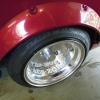Turbo Oil Feed Starvation
Announcements
-
Similar Content
-
Latest Posts
-
This is how I last did this when I had a master cylinder fail and introduce air. Bleed before first stage, go oh shit through first stage, bleed at end of first stage, go oh shit through second stage, bleed at end of second stage, go oh shit through third stage, bleed at end of third stage, go oh shit through fourth stage, bleed at lunch, go oh shit through fifth stage, bleed at end of fifth stage, go oh shit through sixth stage....you get the idea. It did come good in the end. My Topdon scan tool can bleed the HY51 and V37, but it doesn't have a consult connector and I don't have an R34 to check that on. I think finding a tool in an Australian workshop other than Nissan that can bleed an R34 will be like rocking horse poo. No way will a generic ODB tool do it.
-
Hmm. Perhaps not the same engineers. The OE Nissan engineers did not forsee a future with spacers pushing the tie rod force application further away from the steering arm and creating that torque. The failures are happening since the advent of those things, and some 30 years after they designed the uprights. So latent casting deficiencies, 30+ yrs of wear and tear, + unexpected usage could quite easily = unforeseen failure. Meanwhile, the engineers who are designing the billet CNC or fabricated uprights are also designing, for the same parts makers, the correction tie rod ends. And they are designing and building these with motorsport (or, at the very least, the meth addled antics of drifters) in mind. So I would hope (in fact, I would expect) that their design work included the offset of that steering force. Doesn't mean that it is not totally valid to ask the question of them, before committing $$.
-
The downside of this is when you try to track the car, as soon as you hit ABS you get introduced to a unbled system. I want to avoid this. I do not want to bleed/flush/jack up the car twice just to bleed the f**kin car.
-
But again, the engineers said your cast aluminium would be fine based on the load that would be stretching that section. Same load stretching the bolts in a flex (not the twist), with a much smaller cross sectional area than the original part you've broken. It's why you'd need to be using higher strength bolts, but that's just making up for the strength you lose with less area...








Recommended Posts
Create an account or sign in to comment
You need to be a member in order to leave a comment
Create an account
Sign up for a new account in our community. It's easy!
Register a new accountSign in
Already have an account? Sign in here.
Sign In Now